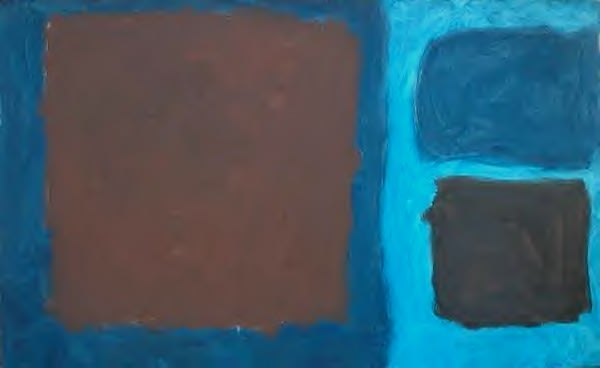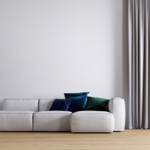Patrick Heron 1920-1999
Blues with Brown Area, 1962
Oil on canvas
76.2 x 122 cms
30 x 48 1/16 ins
30 x 48 1/16 ins
1258
Sold
This painting dates from the most important period of the artist's career, when his abstraction was at its most radical, contributing to an international modernist context that linked it to...
This painting dates from the most important period of the artist's career, when his abstraction was at its most radical, contributing to an international modernist context that linked it to the pioneering paintings of Mark Rothko and Barnett Newman.
In 1962, the year of the present painting, Heron also wrote one of his key statements about his intentions as an artist. Heron explained that:
"For a long time now I have realised that my over-riding interest is colour. Colour is both the subject and the means; the form and content; the image and the meaning in my painting today.
It is obvious that colour is now the only direction in which painting can travel. Painting still has a continent left to explore, in the direction of colour (and in no other direction) .... It seems obvious to me that we are still only at the beginning of our discovery and enjoyment of the superbly exciting facts of the world of colour. One reels at the colour possibilities now; the varied and contrasting intensities, opacities, transparencies; the seeming density and weight, warmth, coolness, vibrancy, or the superbly inert 'dull' colours - such as the marvellously uneventful expanses of the surface of an old green door in the sunlight. Or the terrific zing of a violet vibration ... a violent violet flower, with five petals, suspended against the receptive furry green of leaves in a greenhouse! ... Certainly I can get a tremendous thrill from suddenly seeing two colours juxtaposed - anywhere, indoors or out (but I am no landscape painter in disguise, incidently). I do not find myself "designing" a canvas: I do not "draw" the lozenge-shaped areas or the soft squares. And these forms are not really "forms" at all, anyway, but simply areas (of soft vermilion? violet? ceruleum? brown ochre?) materialising under my brush when I start to try to saturate the surface of the canvas with, so to speak, varying quantities of this colour or that.
I therefore have the feeling that colour determines the actual shapes, or areas, which balance one another in my painting. And let me say that I have turned my back on the idea of a uniformly covered canvas, empty of all but one tone without interruption or incident of any kind .... "
Patrick Heron, 'A Note on my Painting: 1962', catalogue of Galerie Charles Lienhard exhibition, Zurich, January 1963 and reprinted in Art International, 25 February 1963
Elaborating on the importance of his paintings of this period Heron later reflected that:
"The soft edged squares were to replace the bands and stripes entirely, as the predominant units of composition in my work; and in fact, between 1959 and 1963 I did little else but juggle with them, sometimes whittling them down to one - a single soft square floating in, rather than on, a huge ground: either edging up into one of the corners or moving, almost invisibly, along one of the canvas's edges as if drawn by a magnet. And it was at this time that something first happened which I see has gone on happening, at intervals, ever since: namely, the sweeping or sucking to one side of the canvas of all the individual formal units so that they end up clustered along, or piled against, the right-hand edge, leaving three-quarters of the picture area empty of incident... the pushing around, with a big brush, of a certain quantity of colour, was the means I used for arriving at the so-called shapes. One physically moved the rival areas of colour in relation to each other and the big brush moved rapidly - until they met and collided; colour areas thus mutually defined one another by edging into each other physically ... And always in my painting, at all periods, the edges of the canvas have been all-important".
Patrick Heron, 'The Shape of Colour', Studio International, February 1974
In 1962, the year of the present painting, Heron also wrote one of his key statements about his intentions as an artist. Heron explained that:
"For a long time now I have realised that my over-riding interest is colour. Colour is both the subject and the means; the form and content; the image and the meaning in my painting today.
It is obvious that colour is now the only direction in which painting can travel. Painting still has a continent left to explore, in the direction of colour (and in no other direction) .... It seems obvious to me that we are still only at the beginning of our discovery and enjoyment of the superbly exciting facts of the world of colour. One reels at the colour possibilities now; the varied and contrasting intensities, opacities, transparencies; the seeming density and weight, warmth, coolness, vibrancy, or the superbly inert 'dull' colours - such as the marvellously uneventful expanses of the surface of an old green door in the sunlight. Or the terrific zing of a violet vibration ... a violent violet flower, with five petals, suspended against the receptive furry green of leaves in a greenhouse! ... Certainly I can get a tremendous thrill from suddenly seeing two colours juxtaposed - anywhere, indoors or out (but I am no landscape painter in disguise, incidently). I do not find myself "designing" a canvas: I do not "draw" the lozenge-shaped areas or the soft squares. And these forms are not really "forms" at all, anyway, but simply areas (of soft vermilion? violet? ceruleum? brown ochre?) materialising under my brush when I start to try to saturate the surface of the canvas with, so to speak, varying quantities of this colour or that.
I therefore have the feeling that colour determines the actual shapes, or areas, which balance one another in my painting. And let me say that I have turned my back on the idea of a uniformly covered canvas, empty of all but one tone without interruption or incident of any kind .... "
Patrick Heron, 'A Note on my Painting: 1962', catalogue of Galerie Charles Lienhard exhibition, Zurich, January 1963 and reprinted in Art International, 25 February 1963
Elaborating on the importance of his paintings of this period Heron later reflected that:
"The soft edged squares were to replace the bands and stripes entirely, as the predominant units of composition in my work; and in fact, between 1959 and 1963 I did little else but juggle with them, sometimes whittling them down to one - a single soft square floating in, rather than on, a huge ground: either edging up into one of the corners or moving, almost invisibly, along one of the canvas's edges as if drawn by a magnet. And it was at this time that something first happened which I see has gone on happening, at intervals, ever since: namely, the sweeping or sucking to one side of the canvas of all the individual formal units so that they end up clustered along, or piled against, the right-hand edge, leaving three-quarters of the picture area empty of incident... the pushing around, with a big brush, of a certain quantity of colour, was the means I used for arriving at the so-called shapes. One physically moved the rival areas of colour in relation to each other and the big brush moved rapidly - until they met and collided; colour areas thus mutually defined one another by edging into each other physically ... And always in my painting, at all periods, the edges of the canvas have been all-important".
Patrick Heron, 'The Shape of Colour', Studio International, February 1974
Provenance
Patrick HeronThe artist's Family
Waddington Galleries, London
Private collection
Exhibitions
Victor Waddington: A Tribute, Theo Waddington, London, 1993.From the Artist's Studio. Paintings by Patrick Heron, Lillie Art Gallery, Milngavie, Glasgow, 1995.
From the Artist's Studio. Paintings by Patrick Heron, MacLaurin Art Gallery, Ayr, 1995.
Patrick Heron. Works from 1956-1969, Waddington Galleries, London 2002.
The Challenge of Post-War Painting: New Paths for Modernist Art in Britain 1950 - 1965, James Hyman Fine Gallery, London. 3 June - 4 September 2004.
Literature
The Challenge of Post-War Painting: New paths for modernist art in Britain 1950 - 1965, James Hyman Gallery, London. 2004, (cat. 12), detail p.8 and illustrated p.45.1
of
2


